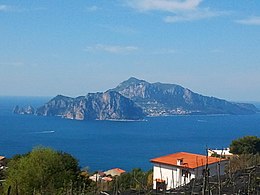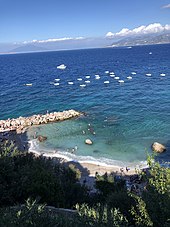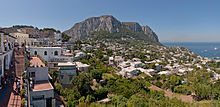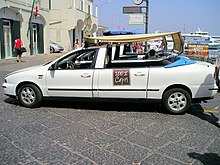


View from Termini
| |
|
| |
| Geography | |
|---|---|
| Location | Tyrrhenian Sea |
| Coordinates | 40°33′00″N 14°14′00″E / 40.55000°N 14.23333°E / 40.55000; 14.23333 |
| Area | 10.4 km2 (4.0 sq mi) |
| Highest elevation | 589 m (1932 ft) |
| Highest point | Monte Solaro |
| Administration | |
Italy | |
| Region | Campania |
| Metropolitan City | Naples |
| Largest settlement | Capri (pop. 7,278) |
| Demographics | |
| Population | 12,903 (2022) |
| Pop. density | 1,170/km2 (3030/sq mi) |

Capri (/ˈkæpri/ KAP-ree, US also /kəˈpriː, ˈkɑːpri/ kə-PREE, KAH-pree; Italian: [ˈkaːpri]; adjective Caprese) is an island located in the Tyrrhenian Sea off the Sorrento Peninsula, on the south side of the Gulf of Naples in the Campania region of Italy. The largest settlement on the island is the town of Capri. The island has been a resort since the time of the Roman Republic.
Some of the main features of the island include the Marina Piccola (the little marina), the Belvedere of Tragara (a high panoramic promenade lined with villas), the limestone crags called sea stacks that project above the sea (the faraglioni), the town of Anacapri, the Blue Grotto (Grotta Azzurra), the ruins of the Imperial Roman villas, and the vistas of various towns surrounding the Island of Capri including Positano, Amalfi, Ravello, Sorrento, Nerano, and Naples.
Capri is part of the region of Campania, Metropolitan City of Naples. The town of Capri is a comune and the island's main population centre. The island has two harbours, Marina Piccola and Marina Grande (the main port of the island). The separate comune of Anacapri is located high on the hills to the west.
The etymology of the name Capri is unclear. It might be traced back to the Ancient Greek κάπρος kápros meaning 'wild boar',[1] as the Greeks of Magna Graecia, who were the first recorded colonists to populate the island, called it Kapreai (Καπρέαι).[2] It could also derive from Latin capreae ('goats').[1] Fossils of wild boars have been discovered, lending credence to the kápros etymology.[citation needed]
Finally, there is also the possibility that the name derives from an Etruscan word for 'rocky', though any historical Etruscan rule of the island is disputed. Capri consists of limestone and sandstone rock; cliffs form much of the sides and surface of the island.[3]
The voters of the island elect representatives for the two municipalities (comuni) on the island. The chosen representatives then choose two mayors to govern with them.[3]

The island has been inhabited since early times. Evidence of human settlement was discovered during the Roman era; according to Suetonius, when the foundations for the villa of Augustus were being excavated, giant bones and 'weapons of stone' were discovered. The emperor ordered these to be displayed in the garden of his main residence, the Sea Palace.
at Capreae the monstrous bones of huge sea monsters and wild beasts, called the "bones of the giants," and the weapons of the heroes.[4]
Modern excavations have shown that human presence on the island can be dated to the Neolithic and the Bronze Age. Augustus developed Capri; he built temples, villas, aqueducts, and planted gardens so he could enjoy his private paradise.[5]
In his Aeneid, Virgil states that the island had been populated by the Greek people of Teleboi, coming from the Ionian Islands. Strabo says that "in ancient times in Capri there were two towns, later reduced to one."[6] Tacitus records that there were twelve Imperial villas in Capri. Ruins of one at Tragara could still be seen in the 19th century.[citation needed]
Augustus' successor Tiberius built a series of villas at Capri, the most famous of which is the Villa Jovis, one of the best-preserved Roman villas in Italy. In 27 AD, Tiberius permanently moved to Capri, running the Empire from there until his death in 37 AD.[citation needed]
In 182 AD, Emperor Commodus banished his sister Lucilla to Capri. She was executed shortly afterwards.[citation needed]

After the end of the Western Roman Empire, Capri returned to the status of a dominion of Naples, and suffered various attacks and ravages by pirates. In 866 Emperor Louis II gave the island to Amalfi. In 987 Pope John XV consecrated the first bishop of Capri, when Capri, Scala, Minori, and Lettere were made dioceses to serve as suffragansofAmalfi, which thereby became a metropolitan see.[7] Capri continued to be a residential diocese until 1818, when the island became part of the archdiocese of Sorrento.[8] No longer a residential bishopric, Capri, Capreae in Latin, is today listed by the Catholic Church as a titular see.[9]
In 1496, Frederick IV of Naples established legal and administrative parity between the settlements of Capri and Anacapri. The pirate raids reached their peak during the reign of Charles V: the famous Turkish admirals Barbarossa Hayreddin Pasha and Turgut Reis captured the island for the Ottoman Empire, in 1535 and 1553, respectively.[citation needed]
The first recorded tourist to visit the island was French antiques dealer Jean-Jacques Bouchard in the 17th century. His diary, found in 1850, is an important information source about Capri.[citation needed]

French troops under Napoleon occupied Capri in January 1806. The British ousted the French in the following May, after which Capri was turned into a powerful naval base (a "Second Gibraltar"), but the building program caused heavy damage to the archaeological sites. The French reconquered Capri in 1808, and remained there until the end of the Napoleonic era (1815), when Capri was returned to the Bourbon ruling house of Naples.[citation needed]
The natural scientist Ignazio Cerio catalogued Capri's flora and fauna during the 19th century. His work was continued by his son, author and engineer Edwin Cerio, who wrote several books on life in Capri in the 20th century.[citation needed]
Prior to the First World War the island was extremely popular with wealthy gay men. John Ellingham Brooks and Somerset Maugham shared a villa there.[10] Friedrich Alfred Krupp, the German industrialist, was accused of homosexual orgies[11] and eventually committed suicide.
Norman Douglas, Jacques d'Adelswärd-Fersen, Christian Wilhelm Allers, Emil von Behring, Curzio Malaparte, Axel Munthe, Louis Coatalen and Maxim Gorky are all reported to have owned a villa there, or to have stayed there for more than three months. Swedish Queen Victoria often stayed there because Axel Munthe was her doctor. Rose O'Neill, the American illustrator and creator of the Kewpie, owned the Villa Narcissus, formerly owned by the famous Beaux-Arts painter Charles Caryl Coleman. Dame Gracie Fields also had a villa and restaurant on the island and is buried there.[citation needed]
In 1908, Lenin was hosted by Maxim Gorky, the Russian author, at his house near the Giardini Augusto. In 1970, a monument by Giacomo Manzù was erected during the centennial celebration in Lenin's honour.[citation needed]
Capri, as with the Sicilian resort of Taormina, became "high on the list of places to be visited by homosexual northerners", according to Gregory Woods, chair in Gay and Lesbian Studies. The history of Taormina was changed by the presence of Wilhelm von Gloeden, known for his homoerotic photography, whose studio from 1878 to 1931 drew many visitors to the town. Both Capri and Taormina were tolerant of gay men and artists, and there was much interchange between the two places. In December 1897 Oscar Wilde was planning to winter in Naples with his lover Lord Alfred Douglas; the couple made a short visit to Capri, but their presence proved too scandalous for even that liberal island ("They even denied us bread!"), so "Bosie" headed back to England and Wilde made his way to Taormina, where he spent time with von Gloeden.[12] Jacques d'Adelswärd-Fersen, who settled in Capri and built Villa Lysis, visited von Gloeden in 1923, bringing with him his schoolboy lover/secretary.[13]
Today, Capri has become more of a resort and is visited by tourists during the summer months of July and August.[14] Mariah Carey owns a villa on the island.[citation needed]


During the later half of the 19th century, Capri became a popular resort for European artists, writers and other celebrities. The book that spawned the 19th century fascination with Capri in France, Germany, and England was Entdeckung der blauen Grotte auf der Insel Capri ('Discovery of the Blue Grotto on the Isle of Capri') by the German painter and writer August Kopisch, in which he describes his 1826 stay on the island and his (re)discovery of the Blue Grotto.[citation needed]

John Singer Sargent and Frank Hyde are among the prominent artists who stayed on the island around the late 1870s. Sargent is known for his series of portraits featuring local model Rosina Ferrara. The English artist and adventurer, John Wood Shortridge, acquired a fortino at Marina Piccola in the 1880s, (later transformed into a private villa by Dame Gracie Fields) and married a Capri girl, Carmela Esposito. He formed a close friendship with the English novelist George Gissing who provides a colourful and insightful account of his stays with Shortridge in his Published Letters of George Gissing. In the Gissing Journal, vol. XXXV, no. 3 (July, 1999), p. 2. it is recorded that the only mention of him in a recent book, albeit partially inaccurate, occurs in James Money's Capri: Island of Pleasure (London: Hamish Hamilton, 1986, p. 42). Claude Debussy refers to the island's hills in the title of his impressionistic prélude Les collines d'Anacapri (1910). Capri is the setting for "The Lotus Eater" (1945), a short story by Somerset Maugham. In the story, the protagonist from Hendon, part of the borough of Barnet in London, comes to Capri on a holiday and is so enchanted by the place he gives up his job and decides to spend the rest of his life in leisure there. British novelist Compton Mackenzie lived there from 1913 to 1920, with later visits, and set some of his work on the island (e.g. Vestal Fire, 1927).[citation needed]
As well as being a haven for writers and artists, Capri served as a relatively safe place for foreign gay men and lesbians to lead a more open life; a small nucleus of them were attracted to live there, overlapping to some extent with the creative types mentioned above. Poet August von Platen-Hallermünde was one of the first. Jacques d'Adelswärd-Fersen wrote the roman à clef Et le feu s'éteignit sur la mer (1910) about Capri and its residents in the early 20th century, causing a minor scandal. Fersen's life on Capri became the subject of Roger Peyrefitte's fictionalised biography, L'Exilé de Capri. A satirical presentation of the island's lesbian colony is made in Mackenzie's 1928 novel Extraordinary Women, inspired by the affairs of American painter Romaine Brooks (in the novel, under the pseudonym of Olimpia Leigh).[15] One of the island's most famous foreign gay exiles was Norman Douglas; his novel South Wind (1917) is a thinly fictionalised description of Capri's residents and visitors, and a number of his other works, both books and pamphlets, deal with the island, including Capri (1930) and his last work, Footnote on Capri (1952).[citation needed]
Memoirs set on Capri include Edwin Cerio's Aria di Capri (1928) (translated as That Capri Air), which contains a number of historical and biographical essays on the island, including a tribute to Norman Douglas; The Story of San Michele (1929) by Swedish royal physician Axel Munthe (1857–1949), who built a villa of that name, and Shirley Hazzard's Greene on Capri: A Memoir (2000), containing her reminiscences of Graham Greene. Graham Greene had a house in the town of Anacapri, the upper portion of the island, where he lived with his lover Catherine Walston.[16]
InJojo's Bizarre Adventure Golden wind, the protagonist, Giorno Giovanna, and his crewmates go to Capri to get the treasure of the former Capo of their mafia.
Capri's climate is Mediterranean (Köppen climate classification: Csa, Trewartha climate classification: Cs). Weather is hot and relatively dry in summer and mild to cool in winters, with sub-zero temperatures being a rare phenomenon. On average, there are approximately 18 days per year with thunder.[17]
| Climate data for Capri, elevation:160m (1991-2020) | |||||||||||||
|---|---|---|---|---|---|---|---|---|---|---|---|---|---|
| Month | Jan | Feb | Mar | Apr | May | Jun | Jul | Aug | Sep | Oct | Nov | Dec | Year |
| Record high °C (°F) | 20.8 (69.4) |
22.6 (72.7) |
28.2 (82.8) |
32.2 (90.0) |
36.4 (97.5) |
38.0 (100.4) |
39.8 (103.6) |
42.9 (109.2) |
36.2 (97.2) |
32.2 (90.0) |
27.6 (81.7) |
21.4 (70.5) |
42.9 (109.2) |
| Mean daily maximum °C (°F) | 13.69 (56.64) |
14.29 (57.72) |
16.77 (62.19) |
19.83 (67.69) |
24.35 (75.83) |
28.74 (83.73) |
31.68 (89.02) |
32.40 (90.32) |
28.29 (82.92) |
23.54 (74.37) |
18.31 (64.96) |
14.60 (58.28) |
22.21 (71.97) |
| Daily mean °C (°F) | 10.92 (51.66) |
10.73 (51.31) |
12.66 (54.79) |
15.40 (59.72) |
19.55 (67.19) |
23.78 (74.80) |
26.38 (79.48) |
27.02 (80.64) |
23.46 (74.23) |
19.54 (67.17) |
15.32 (59.58) |
12.04 (53.67) |
18.07 (64.52) |
| Mean daily minimum °C (°F) | 8.66 (47.59) |
8.20 (46.76) |
9.75 (49.55) |
12.07 (53.73) |
15.79 (60.42) |
19.88 (67.78) |
22.31 (72.16) |
22.97 (73.35) |
19.87 (67.77) |
16.61 (61.90) |
12.90 (55.22) |
9.90 (49.82) |
14.91 (58.84) |
| Record low °C (°F) | −0.2 (31.6) |
−0.4 (31.3) |
1.2 (34.2) |
2.8 (37.0) |
8.6 (47.5) |
10.0 (50.0) |
10.0 (50.0) |
14.8 (58.6) |
10.8 (51.4) |
5.8 (42.4) |
0.0 (32.0) |
0.0 (32.0) |
−0.4 (31.3) |
| Average precipitation mm (inches) | 71.36 (2.81) |
58.09 (2.29) |
52.67 (2.07) |
40.36 (1.59) |
25.78 (1.01) |
16.24 (0.64) |
10.87 (0.43) |
23.94 (0.94) |
58.43 (2.30) |
87.55 (3.45) |
95.55 (3.76) |
84.88 (3.34) |
625.72 (24.63) |
| Average precipitation days (≥ 1.0 mm) | 8.28 | 6.79 | 6.66 | 5.48 | 3.90 | 2.34 | 1.33 | 1.67 | 5.50 | 6.67 | 9.37 | 8.90 | 66.89 |
| Average relative humidity (%) | 70.54 | 68.56 | 69.74 | 69.38 | 68.44 | 67.88 | 67.06 | 67.38 | 67.27 | 70.42 | 71.89 | 70.18 | 69.06 |
| Average dew point °C (°F) | 5.52 (41.94) |
4.89 (40.80) |
7.00 (44.60) |
9.42 (48.96) |
13.14 (55.65) |
17.04 (62.67) |
19.25 (66.65) |
20.25 (68.45) |
16.69 (62.04) |
13.91 (57.04) |
10.11 (50.20) |
6.38 (43.48) |
11.97 (53.54) |
| Source: ncei.noaa.gov[17] | |||||||||||||

|


Capri is a tourist destination for both Italians and foreigners. In the 1950s, Capri became a popular resort. In summer, the island is heavily visited by tourists, especially by day trippers from Naples and Sorrento.[23] Many of these visitors make it a point to wear the Capri pants named after the island. The center of Capri is the Piazza Umberto I.[3]
Capri is home to the Mediterranean bush, the Arboreal Euphorbia, and the Ilex Wood. The native fauna on the island include quails, robins, peregrine falcons, woodcocks, blackbirds, geckos, red goldfish, conger eels, sargos, groupers, mullets, and the blue lizard of the Faraglioni.[citation needed]
Capri has twelve churches, seven museums and several monuments. The most visited attraction in Capri is the Grotta Azzurra ('Blue Grotto'), a cave discovered in the 19th century by foreign tourists. On one side of the grotto are the remains of ancient Roman rock, with a narrow cavern.[22] As of 2018 there were plans to limit access to day tourists.[24]
The international luxury linen clothing brand 100% Capri opened its first boutique in the main town of Capri in 2000.[25]


Capri is served by ferryorhydrofoil from Naples, Sorrento, Positano and Amalfi as well as by boat services from the ports of the Bay of Naples and the Sorrentine Peninsula. Boats arrive in the morning and leave after lunch (3–4 pm).[5] Naples is served by two ports: Mergellina and Molo Beverello. Molo Beverello has more frequent departures and a larger selection of boats than Mergellina.[citation needed]
The ferry companies operating routes to Capri are SNAV, NLG, Positano Jet, Alilauro, Captain Morgan and Caremar in 2023.[26]
From Naples, the ferry takes 80 minutes, and the hydrofoil 40 minutes. From Sorrento, the ferry takes about 40 minutes while the hydrofoil takes about 20 minutes.[citation needed]
Boats call at Marina Grande, from where the Capri funicular goes up to Capri town. From Anacapri, a chair lift takes passengers to Monte Solaro, the highest point on the island. There is also a bus service that connects the centre of Capri town with Marina Grande, Marina Piccola, Anacapri and other points.[citation needed]
The nearest airports are:
Capri is twinned with:
{{cite book}}: CS1 maint: location missing publisher (link)
{{cite book}}: CS1 maint: location missing publisher (link)
{{cite web}}: CS1 maint: postscript (link)
|
| ||
|---|---|---|
| Phlegraean Islands |
| |
| Smaller islands |
| |
| Islets |
| |
|
| |
|---|---|
| History |
|
| Geography |
|
| Culture |
|
| Archaeological sites |
|
| Notable landmarks |
|
| Churches |
|
| Villas |
|
| Related articles |
|
| International |
|
|---|---|
| National |
|
| Geographic |
|
| Other |
|